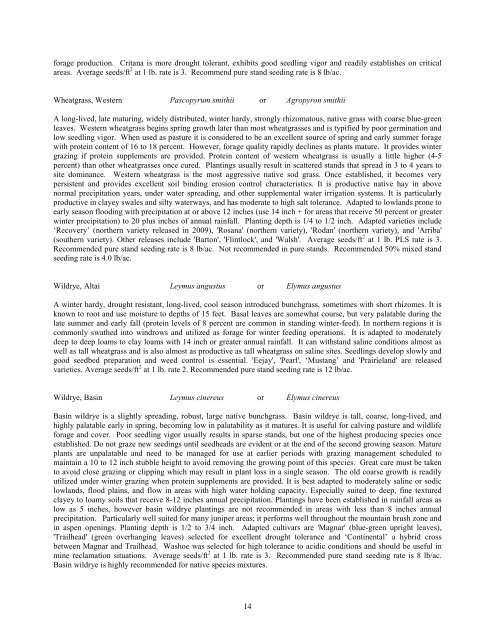Idaho Plant Materials Technical Note No. 24
Idaho Plant Materials Technical Note No. 24
Idaho Plant Materials Technical Note No. 24
You also want an ePaper? Increase the reach of your titles
YUMPU automatically turns print PDFs into web optimized ePapers that Google loves.
forage production. Critana is more drought tolerant, exhibits good seedling vigor and readily establishes on critical<br />
areas. Average seeds/ft 2 at 1 lb. rate is 3. Recommend pure stand seeding rate is 8 lb/ac.<br />
Wheatgrass, Western Pascopyrum smithii or Agropyron smithii<br />
A long-lived, late maturing, widely distributed, winter hardy, strongly rhizomatous, native grass with coarse blue-green<br />
leaves. Western wheatgrass begins spring growth later than most wheatgrasses and is typified by poor germination and<br />
low seedling vigor. When used as pasture it is considered to be an excellent source of spring and early summer forage<br />
with protein content of 16 to 18 percent. However, forage quality rapidly declines as plants mature. It provides winter<br />
grazing if protein supplements are provided. Protein content of western wheatgrass is usually a little higher (4-5<br />
percent) than other wheatgrasses once cured. <strong>Plant</strong>ings usually result in scattered stands that spread in 3 to 4 years to<br />
site dominance. Western wheatgrass is the most aggressive native sod grass. Once established, it becomes very<br />
persistent and provides excellent soil binding erosion control characteristics. It is productive native hay in above<br />
normal precipitation years, under water spreading, and other supplemental water irrigation systems. It is particularly<br />
productive in clayey swales and silty waterways, and has moderate to high salt tolerance. Adapted to lowlands prone to<br />
early season flooding with precipitation at or above 12 inches (use 14 inch + for areas that receive 50 percent or greater<br />
winter precipitation) to 20 plus inches of annual rainfall. <strong>Plant</strong>ing depth is 1/4 to 1/2 inch. Adapted varieties include<br />
‘Recovery’ (northern variety released in 2009), 'Rosana' (northern variety), 'Rodan' (northern variety), and 'Arriba'<br />
(southern variety). Other releases include 'Barton', 'Flintlock', and 'Walsh'. Average seeds/ft 2 at 1 lb. PLS rate is 3.<br />
Recommended pure stand seeding rate is 8 lb/ac. <strong>No</strong>t recommended in pure stands. Recommended 50% mixed stand<br />
seeding rate is 4.0 lb/ac.<br />
Wildrye, Altai Leymus angustus or Elymus angustus<br />
A winter hardy, drought resistant, long-lived, cool season introduced bunchgrass, sometimes with short rhizomes. It is<br />
known to root and use moisture to depths of 15 feet. Basal leaves are somewhat course, but very palatable during the<br />
late summer and early fall (protein levels of 8 percent are common in standing winter-feed). In northern regions it is<br />
commonly swathed into windrows and utilized as forage for winter feeding operations. It is adapted to moderately<br />
deep to deep loams to clay loams with 14 inch or greater annual rainfall. It can withstand saline conditions almost as<br />
well as tall wheatgrass and is also almost as productive as tall wheatgrass on saline sites. Seedlings develop slowly and<br />
good seedbed preparation and weed control is essential. 'Eejay', 'Pearl', ‘Mustang’ and 'Prairieland' are released<br />
varieties. Average seeds/ft 2 at 1 lb. rate 2. Recommended pure stand seeding rate is 12 lb/ac.<br />
Wildrye, Basin Leymus cinereus or Elymus cinereus<br />
Basin wildrye is a slightly spreading, robust, large native bunchgrass. Basin wildrye is tall, coarse, long-lived, and<br />
highly palatable early in spring, becoming low in palatability as it matures. It is useful for calving pasture and wildlife<br />
forage and cover. Poor seedling vigor usually results in sparse stands, but one of the highest producing species once<br />
established. Do not graze new seedings until seedheads are evident or at the end of the second growing season. Mature<br />
plants are unpalatable and need to be managed for use at earlier periods with grazing management scheduled to<br />
maintain a 10 to 12 inch stubble height to avoid removing the growing point of this species. Great care must be taken<br />
to avoid close grazing or clipping which may result in plant loss in a single season. The old coarse growth is readily<br />
utilized under winter grazing when protein supplements are provided. It is best adapted to moderately saline or sodic<br />
lowlands, flood plains, and flow in areas with high water holding capacity. Especially suited to deep, fine textured<br />
clayey to loamy soils that receive 8-12 inches annual precipitation. <strong>Plant</strong>ings have been established in rainfall areas as<br />
low as 5 inches, however basin wildrye plantings are not recommended in areas with less than 8 inches annual<br />
precipitation. Particularly well suited for many juniper areas; it performs well throughout the mountain brush zone and<br />
in aspen openings. <strong>Plant</strong>ing depth is 1/2 to 3/4 inch. Adapted cultivars are 'Magnar' (blue-green upright leaves),<br />
'Trailhead' (green overhanging leaves) selected for excellent drought tolerance and ‘Continental’ a hybrid cross<br />
between Magnar and Trailhead. Washoe was selected for high tolerance to acidic conditions and should be useful in<br />
mine reclamation situations. Average seeds/ft 2 at 1 lb. rate is 3. Recommended pure stand seeding rate is 8 lb/ac.<br />
Basin wildrye is highly recommended for native species mixtures.<br />
14
















